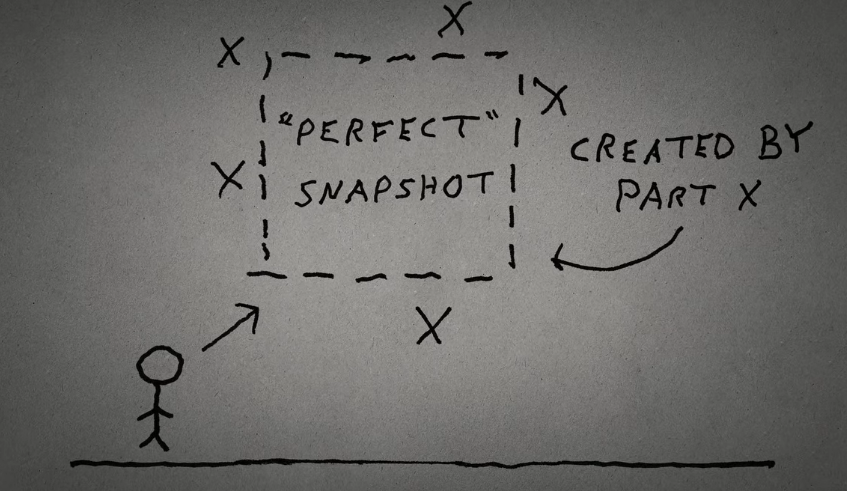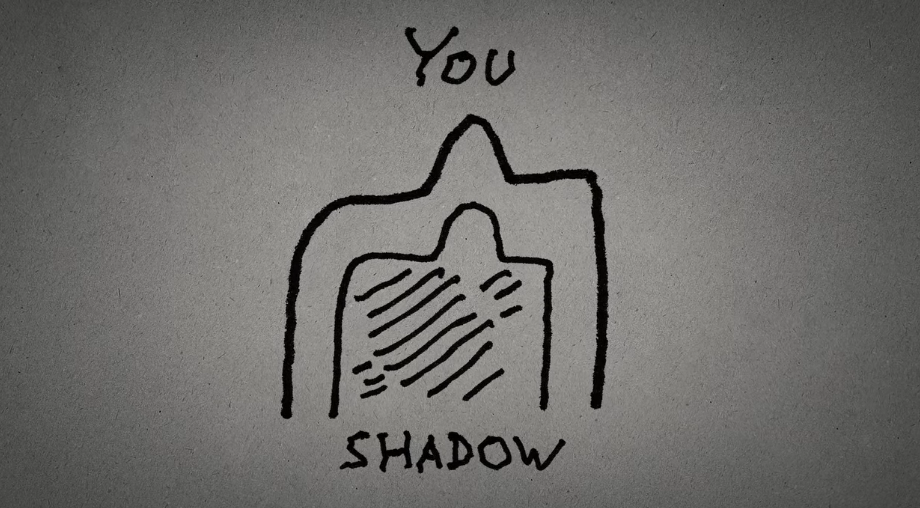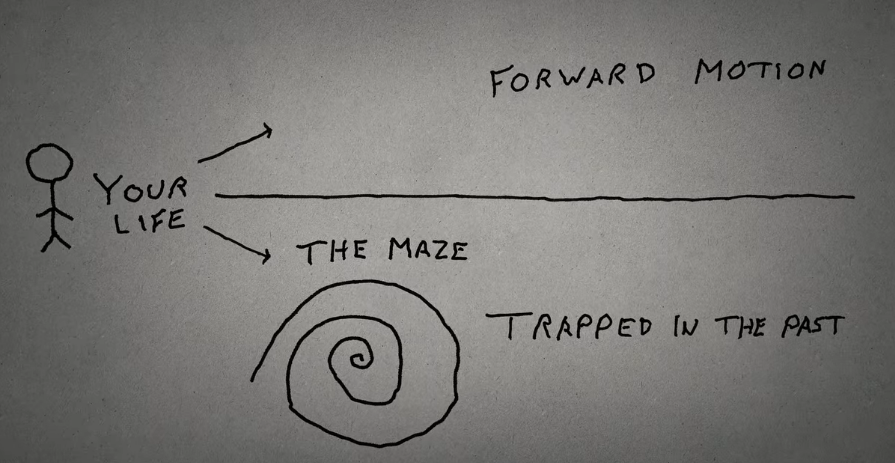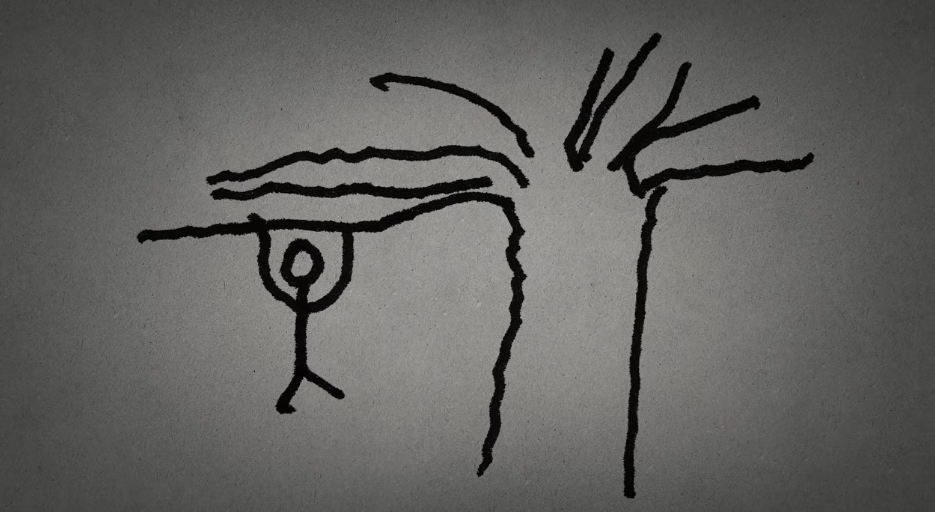Fragileness is a channel to connect with yourself
Your perception is the source of pain
On the way to pursue mental health, I have tried psychological counseling, NLP (Neuro-Linguistic Programming, Mind-Linguistic Programming), Theta Healing, meditation and other methods, and the thing I have experienced the most is "reshaping cognition". People feel pain because of the dominance of individual cognition, that is to say, if the same thing happens to different people, they must have different emotional reactions. It is how the heart perceives objective facts and then produces subjective feelings. In fact, we have been instilled with such views since we were young. I believe most of us have heard the story of how optimistic and pessimistic people view half a glass of water; but the story only reveals cognitive differences, but does not guide us how to change ourselves cognition. Based on this point, how to change cognition has become the starting point of many psychotherapies, and it is also the main purpose of the various "tools (The tools)" in the documentary "Starz's Healing Way".
Why did Phil Stutz, one of the protagonists of "Stutz's Healing Way", a well-known American counselor, create these "tools"? This goes back to the common people's impression of psychotherapy, most of which are "expensive", "time-consuming", and "the short-term effect is not obvious". Reducing psychological stress means lacking immediate results. Stutz tries to reshape the public's stereotypes about psychotherapy, and hopes that every visitor can feel that he has changed when he walks out of the consultation room. The "tool" is the answer based on his years of professional experience. Stutz's case and close friend, as well as a Hollywood actor and another protagonist of the film—Jonah Hill, during the five years of meeting and talking with Stutz, felt the power of "tools" and was eager to introduce them to the public. Thus was born The Way of Healing.

Everyone's Inner Part X
Stutz proposed that each of us has an existence called "Part X", which is the critical and anti-social part of our heart, which blocks our potential, tells us what can't be done, and creates the underlying fear . But psychotherapy is not to eliminate Part X, because it is its negative energy that gives us the motivation to grow and improve. If it is eliminated, our story will end.
Part X will also create a "perfect snapshot", which is the projection of the ideal in our hearts. We always imagine that we can enter that illusion, and then we can achieve happiness. But Stutz reminded that the characteristics of snapshots are "no depth, static", which is far from the actual appearance of life; if you really enter the perfect snapshot, you will find that nothing has changed, and we still have to continue Facing the three elements of reality: "Pain", "Uncertainty", and "Constant work", only by learning to enjoy the process of facing these elements can it be possible to be happy.

Life is made up of one action after another
When suffering from severe inner pain, people usually lose their vitality, because Part X will feel: everything should be fair, everything should be carried out as we think, so we are trapped in the maze of past experience. Stutz tells us: Every effort before reaching the goal, no matter how big or small, correct or not, has the same value. We can regard every action as a pearl. The key is to continue to string the next pearl and tell yourself : "I am the one who puts the next pearl on the string." Because true confidence is living in uncertainty, willing to take risks, upholding one's own beliefs, and the one who bears the corresponding results is the winner; Even if the action is not perfect (every pearl will have a shit), affirming the value of your actions and maintaining the motivation to move forward is one of the ways to fight Part X when you are powerless.
But what should we do when we lose our purpose in life and we don't even have a direction to move forward? Stutz demonstrates the need to start by stimulating life force. The structure of life force (Life force) can be described by a three-layer pyramid, the bottom layer is "you and the body (Body)", the middle layer is "you and other people (People)", and the upper layer is "you and yourself (Yourself)" , Connect with yourself through these three levels, you can stimulate your own vitality and feel the direction guided by life. In front of the "body", the things we have to do are very basic, such as eating well, sleeping well, and exercising. These things not only make the body function smoothly, but also nourish our soul. The "others" in the middle represent all the human beings in the world. Interaction with others can bring you back to your original life when you are off track; Born, positive impact can be seen no matter what. Establishing a connection with "self" refers to exploring the subconscious mind and seeing what is in it. For example, through writing, we can capture the thoughts in the subconscious mind, so as to enhance your relationship with yourself, and even discover things that have never been discovered before , get closer to yourself.

Tools to Change Perception
So far, Stutz has portrayed the basic appearance of human psychology: it is Part X that causes internal fear, criticism, and anxiety, while external factors such as inevitable pain, uncertainty, and continued survival accompany life; to resist these internal, In the face of external resistance, the best strategy is to continue to act, affirm the value of one's actions, and follow the three levels of the vitality pyramid to find the direction of life.
But even with the knowledge of the above resistance and methods, the painful moments are still unbearable. In order to ease the mood of the moment, Stutz proposed four tools to help us transform our cognition: inner shadow (Shadow), active love (Active love), grateful flow (The grateful flow) and loss processing (Loss processing).
- Inner Shadow (Shadow)
Everyone has a shadow inside, a part of us that we don't want the outside world to see. The shadow makes us feel inferior, embarrassed, including those scenes of rejection, which is a part we don't want, but we can't get rid of.
Stutz tells us how to interact with the inner shadow, what it needs is "attention". To discover the shadow, first recall those embarrassing and inferior scenes, and then talk to it, how did you treat it in the past? how does it feel to you How does it feel? We all need to admit that in the past, we lacked attention to a part of ourselves and only wanted to hide it; through this process, we can finally face up to the existence of the shadow, we can start to make up for it, and become one with it instead of turning a blind eye. Synchronizing with the shadow, we contain all that is within us, and thus feel complete, which means we don't need anything else, which makes us feel free.

- Active love
Part X will create The maze, and keep us stuck in the past, wondering if anyone could do something to make up for the injustice I experienced or give what I deserve. However, the time we're stuck in the past won't come back, it's just wasted.

To make up for this dissatisfaction, Stutz asks us to imagine a universe full of love, to feel that we have received all the love, and then you become the person who dominates the love, and then pass this love on to the person you hate, resent, feel this A love went into them that even made you one. When you feel yourself giving love to the person you hate the most, it creates a sense of conquest, makes you feel confident, feels whole, and helps you get out of the maze.
- The grateful flow
Sometimes I always feel that the days are covered in a dark cloud. The dark cloud is like the negative flow caused by Part X. The days without seeing the sun are so long that you almost forget its existence. Stutz's childhood experience of co-flying an airplane with his father made him understand: Through the clouds, the sun is there, and there is no need to judge the nature of reality based on five minutes of experience now.
The way to break through the clouds is to be grateful, you have to believe that there is always something positive (the sun) even if we can't see it directly. Close your eyes, imagine three or four small things that you are grateful for, and focus on saying them, feeling yourself caught up in the flow. The point is not the thing to be grateful for, the very act of experiencing gratitude changes our emotions. The best time to use this tool is when emotions are out of control, because the worst way to deal with these emotions is to argue with them, which will only end up having a negative impact.

- Loss processing
Losing someone, something, or something we love is the worst possible situation for us, and we worry about losing it even before it actually happens. In response to loss, Stutz suggested this: To gain the power of non-attachment, we can still pursue what we think, but it doesn't matter if we don't get it. Every time you are afraid of losing, try to let yourself be detached, but the point is not to become completely detached, just moving in this direction will help, train yourself slowly, don't let losing a thing take away your wholeness Spend.
The power of non-attachment can be enhanced by imagining the following: Pick an object that you are attached to, and imagine that you are holding on to it, like a tree trunk, and you are afraid to let go, because it seems that if you let go, something terrible will happen. But in the end you let go, and then you start to fall. Unexpectedly, the process of falling is not as scary as imagined, even a little gentle, and then you think in your heart: "I am willing to lose everything", to feel the intention behind it. Then your body hits the sun, burns out, and becomes a beam of sunlight that radiates all around, with love; and then there are more of the same sun around, and they say in unison, "We are everywhere." In this imaginary world, all you can do is give, not ask.

Cherish the opportunity to show vulnerability
Another protagonist, Hill, is hardly mentioned in the text, but it doesn't mean that he is not important. In the film, we use Hill to expose one by one self-wounds, so that we can better understand when we can use the tools created by Stutz, and we can also see the process of his healing on the screen; in reverse, around the middle of the film, Stutz He began to talk about his physical problems and previous traumas. Obviously, he has not completely escaped from these pains. Even if he can heal others, he is already in his seventies and has spent a lot of time with these problems. Surprisingly, during the Q&A with Hill, although he didn’t use the tools mentioned above, he could also see the change in Stutz’s heart. It can be said that after filming this film and having a deeper connection with Hill, he became Stutz’s self part of the healing.
Thank you Stutz and Hill for unreservedly showing their fragility and revealing to us: no matter whether it seems to meet the secular definition of success, how many people admire you, as a person, you have to face the same struggle and struggle. In a society where we are taught to bring out the best in ourselves, it takes a lot of courage and luck to even realize that we can be vulnerable; but only by facing all that is inside, can we fully experience all aspects of life that life has to offer us, and continue to push forward This is the way to go.
References
- Netflix | Starz's Way of Healing
- God of Movies| 【Film Review】"Starz's Way of Healing": Uncovering inner fragility and childhood trauma, a two-way healing journey
Like my work? Don't forget to support and clap, let me know that you are with me on the road of creation. Keep this enthusiasm together!


